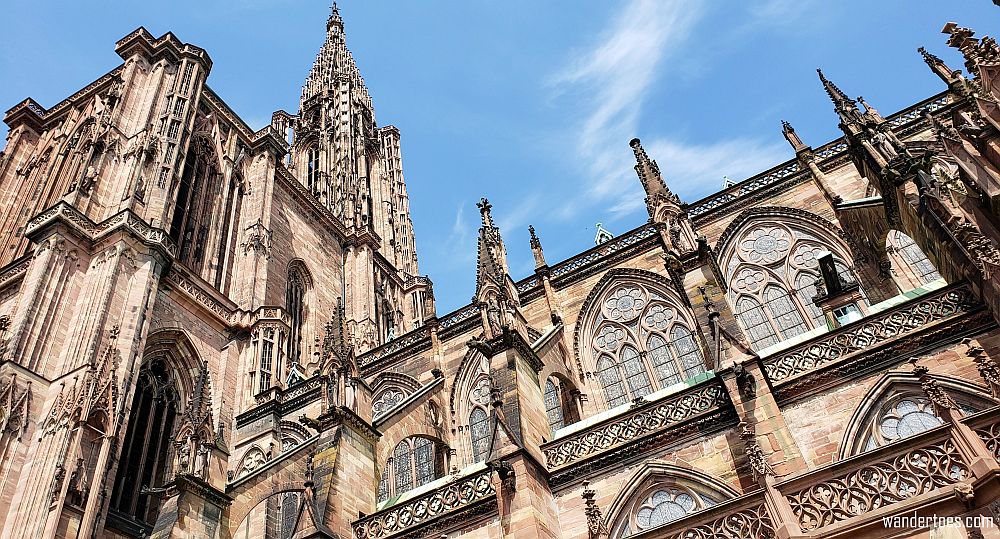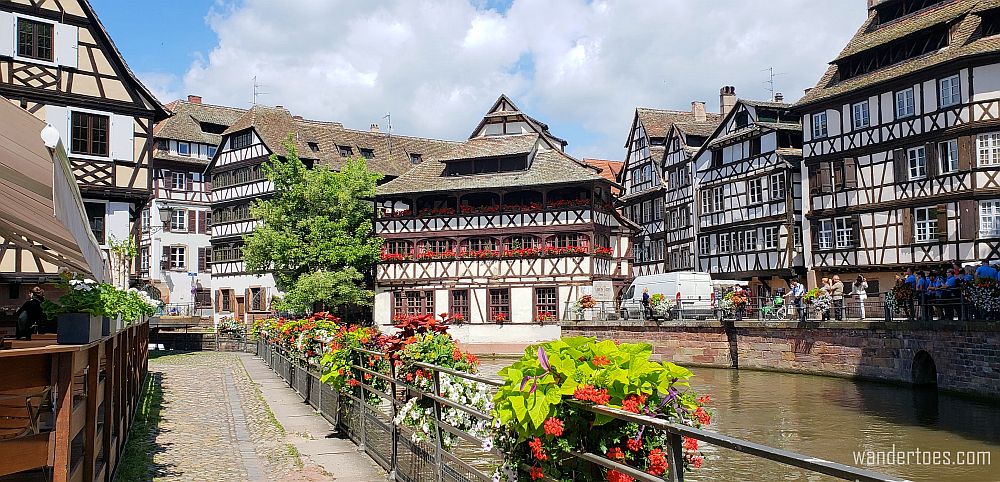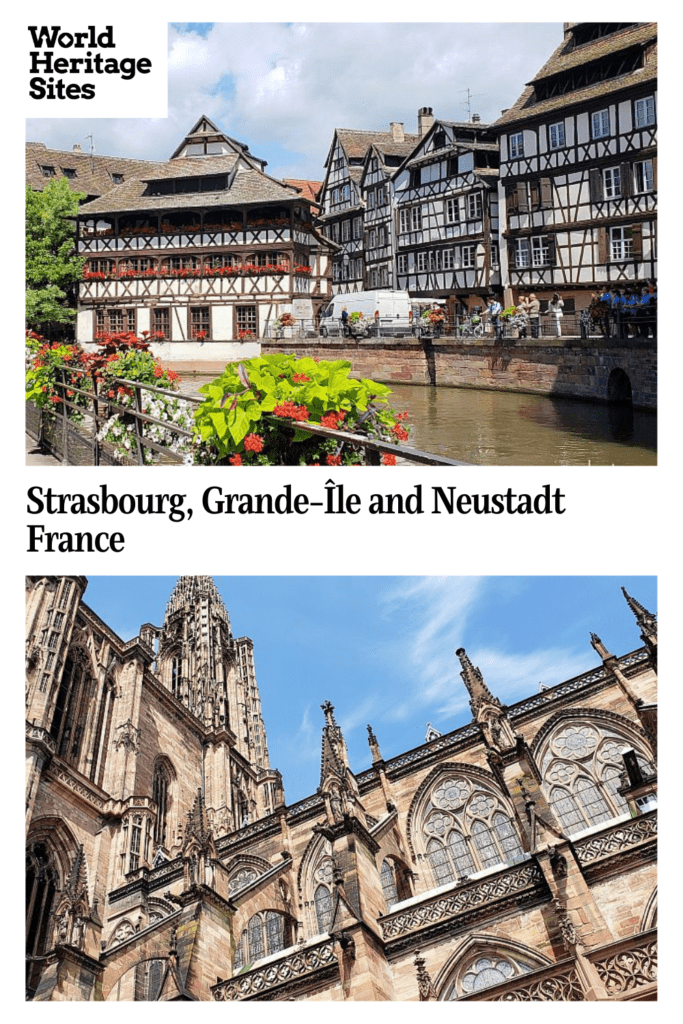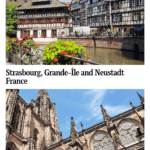Strasbourg, Grande-Île and Neustadt
By Megan
What is Strasbourg, Grande-Île and Neustadt?
Strasbourg is a French city on the Franco-German border, along the Rhine River. The city has been conquered and re-conquered (and re-conquered, and reconquered) between France and Germany throughout history. Because of this, both French and German influences have shaped Strasbourg.
Disclosure: This article contains affiliate links. Making a purchase through an affiliate link will mean a small commission for this website. This will not affect your price. Privacy policy.
The Grande-Île & Neustadt are two adjacent and complementary areas of Strasbourg. The Grande-Île, or “large island,” is at the heart of the city. It is home to the historic center with architecture reaching back as far as Gothic styles. The Neustadt district borders the Grand-Île and was built during the Reichsland period, from 1871 to 1918. It is one of the last examples of late 19th-century German architecture.

Why are Grande-Île and Neustadt a UNESCO World Heritage site?
Strasbourg’s Grande-Île was named a UNESCO World Heritage Site in 1988 and was the first entire city center to be listed. It was given this honor because the Grande-Île “exemplified medieval cities” with its gothic Cathedral influenced by Romanesque art, its winding, narrow streets, and its half-timbered houses. While the historic center has been modernized for safety and sanitation, it has done so with respect for the history of the area, conserving its characteristics. The Vauban dam, which dates from the 1600s, has been adapted to new use while also ensuring its preservation.
The heart of the Neustadt district was added to the UNESCO World Heritage listing in 2017. This part of the city was built during German rule, embracing both the French Haussmann’s and Austrian Sitte’s influences regarding modern city planning. The major public buildings within the Neustadt have kept their original size, physical qualities, and building materials while also keeping up with modern building standards. The Neustadt is recognized for its outstanding continuity in the urban landscape.
When inducting the Neustadt alongside the Grande-Île as a World Heritage site, UNESCO recognized the “functional complementarity and landscape continuity” created by the “urban ensemble” of the two areas together. The two adjacent areas of Strasbourg together display the progression of architecture from the 15th century to today. The city successfully features architecture from the significant stages in a manner that does not overshadow any individual one.

What can you expect on a visit to Strasbourg?
Strasbourg is the largest city of the Grand Est region of eastern France, and one of the four capitals of the European Union. Outside of the Grande-Île, the city is completely modern with all necessary conveniences. The main train station is located close to the historic center, and an efficient tram system makes the city easily navigable.
Within the Grand-Île are many historic and worthwhile sites. The Strasbourg Cathedral is a beautiful example of Gothic architecture and is the 4th tallest church in the world. The Cathedral also houses the famous astronomical clock that features a procession of figures of the apostles and Christ at noon, and tracks the position of the sun and the moon and the timing of eclipses.
The Barrage Vauban dates from the 1600s and provides panoramic views of the city from a rooftop terrace. The southwest corner of the Grand-Île is a postcard-perfect Petite France with scenic canals lined by half-timber houses. There is also Place Kléber and its Christmas market, Palais Rohan’s museums, a number of centuries-old churches, restaurants, and more.
The Neustadt invites you to stroll Strasbourg’s version of the Champs-Élysées, the Avenue de la Liberté. Relax in the Place de la République and stop in at the Neo-Renaissance Palais Universitaire with its botanical garden. Along the way be sure to take in some beautiful Art Nouveau buildings.
In addition to the UNESCO sites, Strasbourg is rich in open, green spaces. Several beautiful parks are within the city. including Parc de l’Orangerie with a castle and zoo and Parc Pourtalès with a castle-turned-hotel and outdoor sculpture museum. Strasbourg also offers half or full day wine tours of the Alsace region for those wishing to explore further.
Remember all those years of back and forth conquering and re-conquering between France and Germany? Today a pedestrian bridge spans the Rhine River and connects Strasbourg, France, with Kehl, Germany, as a symbol of friendship between the two towns. You can freely walk back and forth across the bridge from one country to the other.

Is Strasbourg worth visiting?
When I visited Strasbourg, I stayed in the city for six days and thoroughly enjoyed my time there. I explored the UNESCO World Heritage areas and enjoyed all the things to do in Strasbourg including shopping, relaxing in parks, and tasting some wonderful wines. The Gare de Strasbourg is the main rail hub for this region of France, making Strasbourg an excellent home base to explore the region. I highly recommend a visit to Strasbourg with its Grande-Île and Neustadt.
Find accommodations and compare prices in Grande-Île using the map below:
What sorts of travelers would like Strasbourg, Grande-Île and Neustadt?
Strasbourg’s Grande-Île and Neustadt make a fascinating visit for anyone interested in European architecture, history, postcard-perfect photography, and city planning. Visiting Strasbourg will also interest wine-lovers, and those wanting to explore other beautiful towns in Alsace.
Try this half-day wine tour or this full-day wine tour, both leaving from Strasbourg. If wine isn’t your thing, consider this full-day tour of medieval towns near Strasbourg.
Tips for visiting Strasbourg, Grande-Île and Neustadt
The transit system to travel within Strasbourg, and to and from the city, is excellent. The tram system within the city is clean and efficient; using it makes seeing all the sites much easier. Also take advantage of the previously-mentioned rail service around Strasbourg. If you have more time, visit Nancy with its UNESCO World Heritage site, or the picturesque Colmar. However, if a day trip is what you are planning, keep in mind that high speed rail makes even a day trip from Paris possible.
The train systems also allow for easy access to neighbouring countries and their UNESCO world heritage sites. Within an hour you could head to Baden-Baden, one of the Great Spa Towns of Europe, just over the border into Germany.

Where is Strasbourg?
Strasbourg is in eastern France, on the Franco-German border. The city has an international airport and is a rail hub for the Grand Est region of France, so visiting is quite easy. From the Strasbourg train station to Place Kléber in the heart of the Grande-Île is only a 13-minute walk, or about 6 minutes by tram.
Closest major cities:
- Paris: Approximately 500 km (311 miles)
- Stuttgart: Approximately 148 km (92 miles)
- Luxembourg: Approximately 260 km (162 miles)
Travel by car:
- Paris: 4.5-5 hours
- Stuttgart: 1 hour 45 minutes
- Luxembourg: 2 hours 40 minutes
Parking: For €4,10 you can park your car until 1:30am and take the tram into the historic center. The Strasbourg official site has a downloadable PDF with the details.
Travel by train:
- Paris: 1 hour 45 minutes to 2 hours 20 minutes depending on stops.
- Stuttgart: 1 hour 20 minutes
- Luxembourg: 1 hour 30 minutes
For more information about Strasbourg, Grande-Île and Neustadt, opening hours and admission fees for particular sights, see Strasbourg’s official website.
Have you been to Strasbourg? If so, do you have any additional information or advice about this UNESCO World Heritage site? Please add your comments below!

